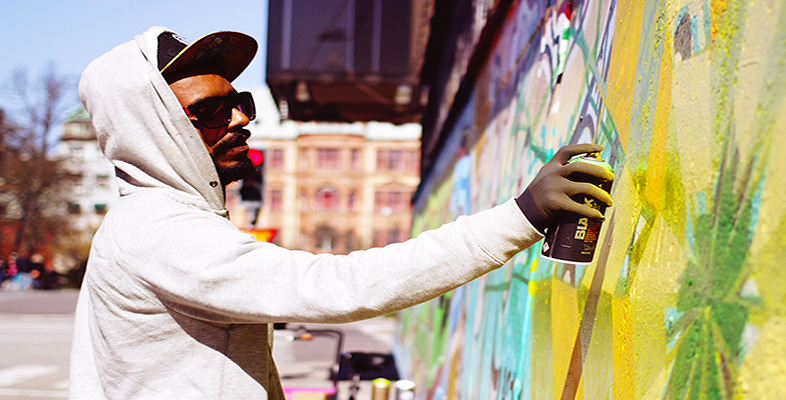8 Graffiti goes mainstream
Not all graffiti is unauthorised or illegal. There are many signs that graffiti is becoming increasingly socially acceptable within mainstream culture. Some local councils offer specifically designated spaces for graffiti, fund local community graffiti art projects and, in some instances, graffiti artists are commissioned to do particular pieces of graffiti art. Graffiti artists were, for example, recently hired to decorate the ceiling above the main altar of a church in l’Hospitalet, near Barcelona. Click on the following link to see a related article [Tip: hold Ctrl and click a link to open it in a new tab. (Hide tip)] on the BBC News website with images of this church (Hadden, 2013).
In recent years, some prestigious mainstream galleries have dedicated entire exhibitions to graffiti art. For example, in 2008 Tate Modern art gallery in London offered its own external walls to graffiti artists to host an open-air graffiti exhibition (click the following link to see the exhibition information on the Tate website). However, what happens when graffiti crosses into the mainstream art world?
Activity 6 Tate Modern’s giant graffiti
Click on the following link to watch ‘Tate Modern‘s giant graffiti’, which is a short video of a BBC News report on Tate Modern’s graffiti exhibition in 2008.
When watching this film think about the following question and make notes in the text box below:
What is the difference between the creation and exhibition of graffiti art on the walls of Tate Modern in London and the creation of illicit graffiti art in the streets of London?
Discussion
The association with Tate Modern, a ‘refined British museum’ and modern art gallery, gives the exhibits a lot of official recognition. However, the display of street art is perceived as a bit of an ‘oddity’ by the reporter and by visitors and passers by interviewed in the film, not least because it is displayed on Tate Modern’s external walls, rather than inside the building. As opposed to the informal settings of illicit graffiti, the graffiti on the walls of Tate Modern are created in a very formal, controlled environment as ‘some of the world’s best graffiti artists’ were presumably approached and selected and assigned particular spaces on the building. Though the short film does not give us information about how the artists were selected, there is reference to hurdles the organisers had to deal with regard to building regulations. Although this is not specifically mentioned in the film, it is also likely that artists had to agree with the gallery on the designs beforehand. The film makes it clear that it had already been formally agreed that the graffiti are going to be removed after a three-month period. While creators of illicit graffiti risk being prosecuted, this is not a risk the artists who worked at Tate Modern had to worry about (even though some artists still preferred not to be filmed and covered their faces). This gave them more time to work on their graffiti, and meant that they did not have to be prepared to ‘spray and run’, that is, be ready to pack up their materials at short notice and run away from the police (like the creators of the Mystery zebras in Hackney). The artists were also given technical assistance by lorries and cranes that could lift them up to reach higher spaces. The walls of Tate Modern gave the artists a very large space to work on, so the graffiti were of unusually ‘colossal’, ‘massive’ dimensions.
Even Cedar Lewisohn, the curator of the ‘Street Art’ exhibition at Tate Modern in 2008, is convinced that ‘the best street art and graffiti are illegal’ (2008, p. 127). He argues that ‘graffiti and street art are essentially acts of rebellion’ (2008, p. 153) and believes that ‘illegal work have political and ethical connotations that are lost in sanctioned works’ (2008, p. 127). He claims that illegal graffiti transfers ‘the sense of danger the artist felt […] to the viewer’, and by contrast, ‘a work of graffiti or street art in a gallery or museum can feel safe as if its wings have been clipped’ (2008, p. 127).
